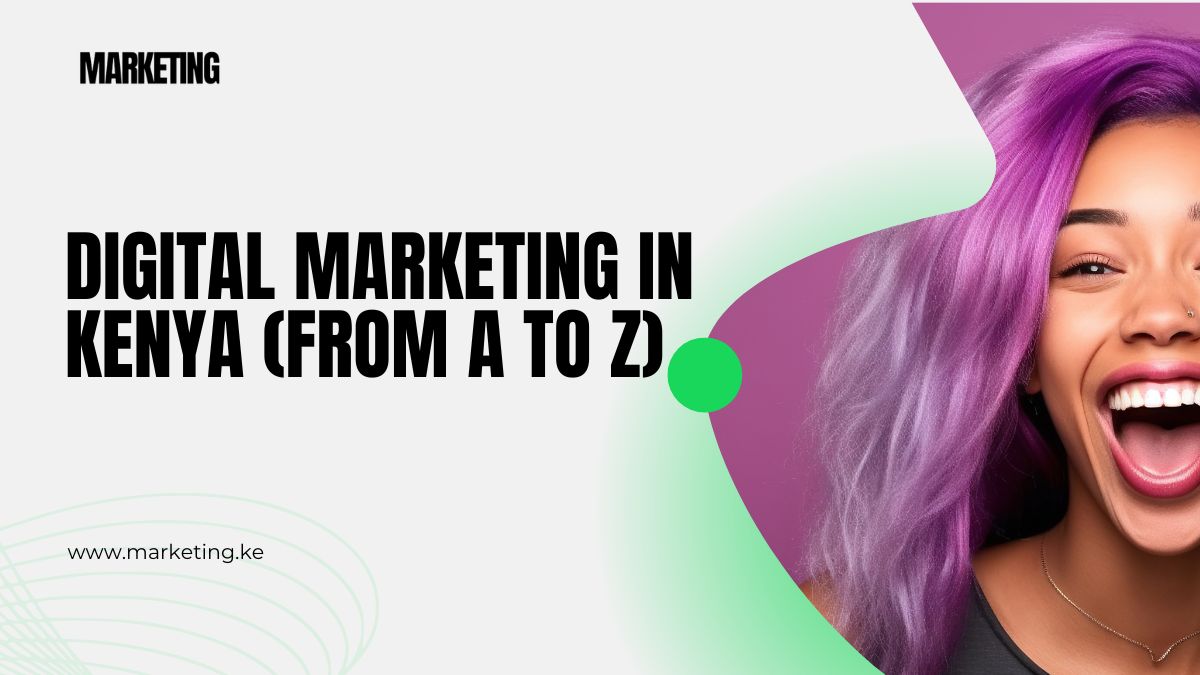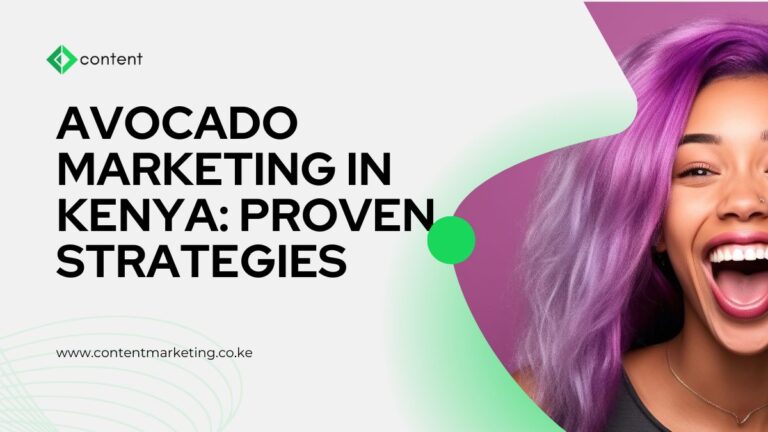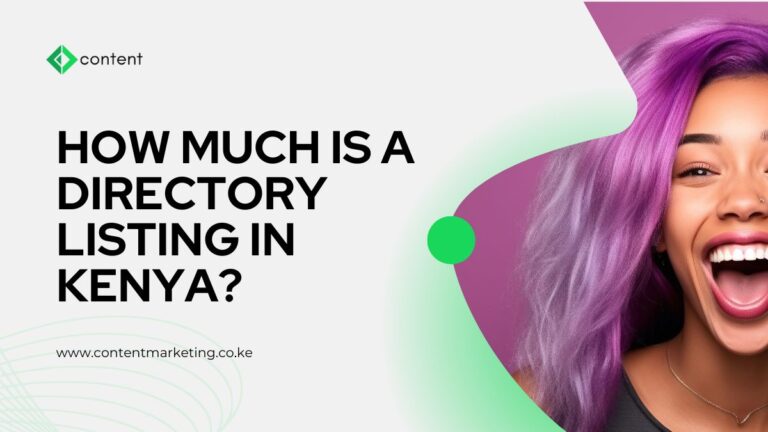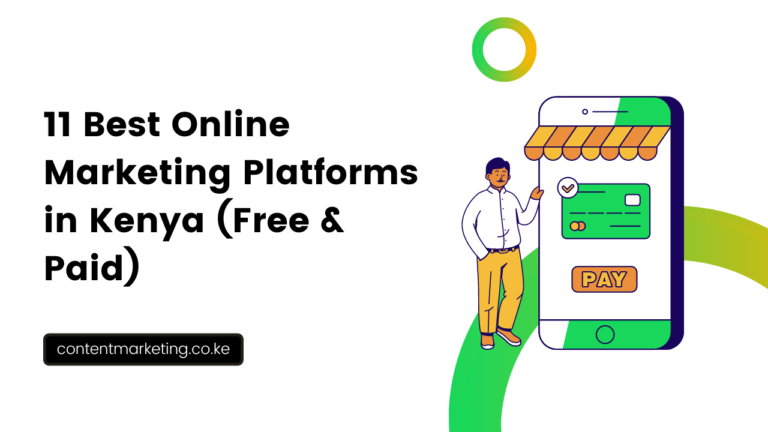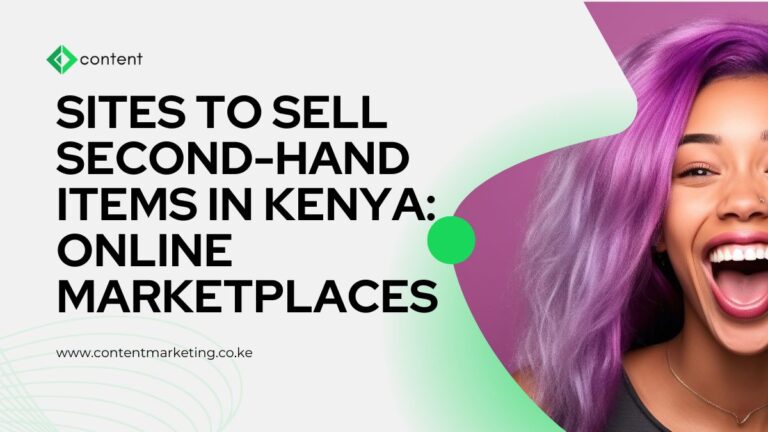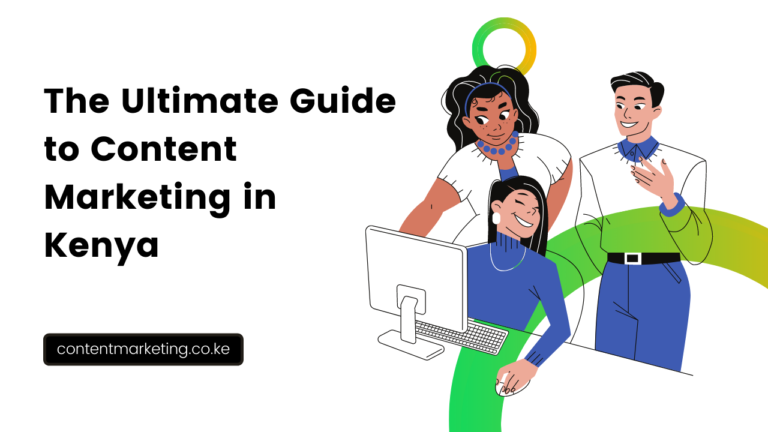Digital Marketing in Kenya (A to Z For Beginners)
Last updated on February 14th, 2024 at 04:06 pm
Over the past decade, digital marketing in Kenya has exploded in popularity.
With increasing internet and smartphone penetration, Kenyan consumers are spending more and more time engaging with digital content and platforms.
This seismic shift presents a huge opportunity for businesses looking to reach this engaged audience.
It’s estimated there are over 50 million internet users in Kenya today.
Popular platforms like Google, Facebook, Instagram, and YouTube now draw millions of Kenyan users every month.
As a result, digital marketing channels have become extremely cost-effective ways for companies to boost brand awareness and drive sales growth.
In this comprehensive guide, we will walk through all the major pillars of digital marketing in Kenya today:
- Search Engine Optimization (SEO) – How to optimize website content to rank higher in Google Kenya for relevant searches.
- Pay-Per-Click (PPC) Advertising – Running targeted ads on platforms like Google and Facebook.
- Social Media Marketing – Developing content and engagement strategies tailored for popular Kenyan platforms.
- Content Marketing – Creating blogs, videos, and other formats that resonate with Kenyan users.
- Email Marketing – Building a subscriber list and email funnel to convert users into customers.
- Analytics & Reporting – Tracking key performance metrics and showing marketing success to key stakeholders.
By the end, you will have a complete understanding of the digital marketing landscape in Kenya and proven tactics to reach Kenyan consumers effectively.
So let’s get started!
Table of Contents
How many Kenyans use the internet?

Before we talk about anything, you need to hear this.
As of January 2023, there were 17.86 million internet users in Kenya, representing an internet penetration rate of 32.7%.
This indicates that approximately 67.3% of the population remained offline at the beginning of 2023.
The number of internet users in Kenya increased by 1.3 million (8.0%) from the previous year.
I wonder, how many Kenyans shop online?
Well, according to a survey conducted by the World Bank, online shopping in Kenya surged from 9% in 2017 to 16% in 2021, the third-highest rate in Africa after Mauritius and Tunisia.
A Mastercard study on consumer spending revealed that nearly four out of five (79%) surveyed consumers in Kenya are shopping more online since the start of the pandemic.
2021 is kind of long time ago, so I expect the number to be up.
Without even explaining, I hope you’ve gotten the point.
What is digital marketing?
Digital marketing is all about promoting and selling products or services using online channels like websites, mobile devices, social media, search engines, and email.
It’s like the modern version of traditional marketing, but instead of billboards and TV ads, you’re using the power of the internet to reach your target audience.
Here are some of the key benefits of digital marketing:
- Reach a wider audience: With the internet, you’re not limited to your local area. You can connect with potential customers all over the world.
- Target your audience more effectively: You can use digital marketing tools to target your ads to specific demographics, interests, and behaviors. This means you’re more likely to reach people who are actually interested in what you have to offer.
- Track your results: With digital marketing, you can track the results of your campaigns in real time. This means you can see what’s working and what’s not, and make adjustments accordingly.
- Build relationships with customers: Social media and email marketing give you a great way to connect with your customers on a personal level. You can share your story, build trust, and create a community around your brand.
If you’re thinking about starting a business or growing an existing one, digital marketing is a great way to reach your target audience and achieve your goals.
Here are some of the most common types of digital marketing in Kenya:
- Search engine optimization (SEO): This involves optimizing your website so that it appears higher in search engine results pages (SERPs). When people search for keywords related to your business, you want your website to be one of the first ones they see.
- Pay-per-click (PPC) advertising: This involves running ads on search engines and other websites. You only pay for the ad when someone clicks on it.
- Social media marketing: This involves using social media platforms like Facebook, Twitter, and Instagram to connect with your target audience. You can share content, run ads, and participate in conversations.
- Content marketing: This involves creating and sharing valuable content that will attract and engage your target audience. This could include blog posts, articles, infographics, videos, and more.
- Email marketing: This involves sending emails to your subscribers to promote your products or services, share news and updates, and build relationships.
Digital marketing in Kenya is a constantly evolving field, so it’s important to stay up-to-date on the latest trends and technologies.
But if you’re willing to put in the work, it can be a powerful tool for growing your business.
Inbound marketing versus digital marketing in Kenya
While both inbound and digital marketing in Kenya involve promoting and selling products or services online, they differ in their approach and goals:
Digital Marketing:
- Broader Scope: Digital marketing is an umbrella term that encompasses various online marketing tactics and tools. It includes strategies like:
- SEO: Optimizing websites to rank higher in search engine results.
- PPC ads: Paid advertising on search engines and websites.
- Social media marketing: Utilizing platforms like Facebook and Instagram to engage with customers.
- Email marketing: Sending targeted emails to promote products or services.
- Content marketing: Creating valuable content (blogs, videos, infographics) to attract and engage an audience.
- Website design and development: Building and maintaining a user-friendly website.
- Focus: Reaching a wider audience and generating immediate leads or conversions.
- Methodology: Can be a mix of inbound and outbound tactics, including push advertising and direct promotion.
Inbound Marketing:
- Specific Methodology: Inbound marketing is a strategic approach focused on attracting and engaging potential customers by providing valuable and relevant content. It includes tactics like:
- Blogging: Sharing informative and engaging blog posts.
- Ebooks and white papers: Offering valuable resources in exchange for contact information.
- Social media content: Creating and sharing content that educates and entertains.
- Email marketing: Nurturing leads with personalized email campaigns.
- Landing pages: Capturing leads through targeted web pages.
- Focus: Building long-term relationships with potential customers and nurturing them through the buyer’s journey.
- Methodology: Primarily uses organic tactics to attract qualified leads who are actively searching for solutions to their problems.
Here’s an analogy:
- Digital marketing is like throwing a big party and inviting everyone. You hope some of the guests will be interested in what you have to offer.
- Inbound marketing is like building a beautiful garden and attracting butterflies. You create an environment that naturally draws in your ideal customers.
Ultimately, the best approach depends on your business goals and budget.
Digital marketing in Kenya can be great for quick bursts of traffic and leads, while inbound marketing fosters long-term relationships and brand loyalty.
You can also combine both approaches for a comprehensive online marketing strategy.
B2B versus B2C digital marketing in Kenya
Lets switch gears and talk about something cooler; B2B versus B2C digital marketing in Kenya.
Both B2B and B2C digital marketing aim to reach customers online, but they cater to vastly different audiences and require distinct approaches.
Here’s a breakdown of their key differences:
Target Audience:
- B2B: Businesses targeting other businesses, often focusing on specific decision-makers within those companies.
- B2C: Individuals or consumers directly purchasing products or services.
Marketing Goals:
- B2B: Building long-term relationships, fostering trust, and influencing complex purchase decisions.
- B2C: Driving immediate sales, generating leads, and creating brand awareness.
Messaging and Tone:
- B2B: Professional, data-driven, and focused on logic and problem-solving.
- B2C: Emotional, engaging, and often driven by storytelling and humor.
Content Strategy:
- B2B: White papers, case studies, webinars, industry reports, and thought leadership content.
- B2C: Social media posts, videos, influencer collaborations, user-generated content, and entertaining blog posts.
Campaign Channels:
- B2B: LinkedIn, industry-specific platforms, email marketing, trade shows, and content syndication.
- B2C: Facebook, Instagram, YouTube, TikTok, influencer marketing, and organic search optimization.
Decision-Making Process:
- B2B: Often involves multiple decision-makers with complex research and evaluation processes.
- B2C: Usually shorter purchase cycles driven by emotions and impulse decisions.
Metrics and Measurement:
- B2B: Lead generation, qualified leads, website traffic, brand awareness, and customer lifetime value.
- B2C: Website traffic, conversions, sales, social media engagement, and customer acquisition cost.
Additionally:
- B2B marketing budgets tend to be larger than B2C due to the higher value of each customer.
- Personalization is crucial in B2B marketing, while B2C often relies on broader targeting.
- Building trust and expertise is essential for B2B success, while B2C often focuses on emotional connection and brand image.
Remember, these are general distinctions, and there may be overlaps depending on your specific industry and target audience.
At the end of the day, the most effective digital marketing strategy in Kenya combines targeted channels, relevant messaging, and valuable content to resonate with your audience and achieve your goals, whether B2B or B2C.
Types of digital marketing in Kenya
As we’ve already mentioned, digital marketing in Kenya comes in different shades.
Let’s look at some of them.
Search Engine Optimization
Search Engine Optimization (SEO) is a crucial foundation for any digital marketing strategy targeting Kenya.
With over 93% of online searches in Kenya happening on Google, ranking highly in Google search results can drive massive amounts of relevant traffic to your website.
The first key step is conducting thorough keyword research to identify high-value terms and questions Kenyan users are searching for related to your business.
Some useful keyword research tools include Google’s Keyword Planner, SEMrush, and Ubersuggest.
Track monthly search volumes and keyword difficulty scores to build your targeting list.
With your targets in place, focus on optimizing on-page content such as page titles, headings, meta descriptions, image alt text, and the body content itself.
Ensure all pages emphasize your most important and relevant keywords, while providing useful information for visitors.
An effective SEO content strategy also includes regularly publishing fresh blog posts, videos, and other media that targets secondary keyword terms you want to rank for over time.
Useful platforms include WordPress blogs, YouTube, and Medium.
To accelerate rankings, build high-quality backlinks from relevant websites and influencers to signal your authority to Google.
Guest posting, resource page listings, local citations and reviews can all help build domain authority and keyword rankings for Kenyan searches.
Closely monitor your core term rankings and organic traffic from Kenya in Google Analytics.
Track which terms drive the most conversions and continue optimizing to build even stronger rankings over the long-term.
Read also:
- SEO in Kenya: How To Rank #1 On Google in Kenya
- Local SEO in Kenya: Expert’s Guide to Improve Your Local Rankings
- No. 1 Website Marketing Services in Kenya (Get Results)
Pay-Per-Click Advertising
Alongside SEO for long-term growth, Pay-Per-Click (PPC) advertising enables businesses to rapidly reach Kenyan consumers searching for relevant products or services.
Major PPC platforms like Google Ads and Microsoft Advertising provide self-service interfaces to launch and manage campaigns targeted specifically for Kenya.
When setting up your PPC campaigns, leverage location targeting options to focus your ads exclusively on users within Kenya.
You can further narrow down the audience using demographics, interests, browse behavior and more.
Define a monthly budget cap and use bidding strategies optimized for conversions or target cost-per-click.
Carefully test out different combinations of ad copy, keywords, landing pages and call-to-action to determine which perform best with the Kenyan audience.
Emphasize keywords in the ad titles and text. Send traffic to dedicated landing pages clearly highlighting your offer and next steps to convert site visitors.
Continuously analyze click-through rates, cost per conversion and overall return on ad spend (ROAS) to refine your PPC strategy over time.
As high-performing elements emerge double down on those while cutting poorly performing areas. Use A/B testing for ongoing optimization.
Read also:
- Pay Per Click Advertising in Kenya: A Step-by-Step Guide
- 5 Sure Ideas for Cost-Effective Advertising in Kenya
Social Media Marketing
This is another huge aspect of digital marketing in Kenya.
With over 9.1 million monthly active Facebook users and booming usage of X, Instagram, TikTok, and YouTube, social platforms present massive opportunities to engage with and influence Kenyan consumers through digital marketing campaigns.
The first step is to research the most popular social platforms in your industry to reach Kenyans.
For example, YouTube and Facebook tend to skew towards older groups, while Instagram and TikTok attract younger demographics.
X (formerly Twitter) also has broad penetration in Kenya, especially in major cities like Nairobi.
Tailor your social branding and messaging to craft content and campaigns specifically tailored for Kenyan culture and conversations.
Partner with influential Kenyan creators, brands, and public figures to produce co-branded social content, sponsorships, takeovers, and other attention-grabbing formats.
Run paid advertising campaigns across multiple platforms using precise demographic, interest, and behavioral targeting options to promote your posts and messaging to relevant segments of the Kenyan social audience.
Continuously optimize creative assets and calls to action to drive higher engagement and click-through rates.
Closely track performance metrics like follower growth, engagement rates, reach, and click-throughs across channels using integrated analytics.
Determine your most important metrics for business impact and double down on content and campaigns that deliver measurable success tied to key goals.
Read also:
- Social Media Marketing in Kenya: Ultimate Guide
- Kenya Social Media Usage: Top Platforms + Numbers
- A Beginner’s Guide To Instagram Marketing in Kenya
Content Marketing
Content marketing in Kenya involves creating and distributing valuable, relevant content to attract and engage a clearly defined audience in Kenya.
The goal is to build awareness, trust, and loyalty over time by consistently providing content that resonates.
An effective content strategy starts by profiling your target customer persona in Kenya.
Define key demographics, interests, pain points, and search behaviors.
Use this profile to create content tailored to their preferences around topics, formats, tone, and more across your website, blog, and social channels.
Useful blog content formats to engage Kenyan users include:
- How-To Guides – Step-by-step tutorials for using a product or service
- Listicles – List posts like “10 Tips for XYZ”
- Q&A – Answering common Kenya customer questions
- Case Studies – Success stories and results from real customers
Video and audio content like YouTube videos, webinars, and podcasts continue growing in popularity across Kenya as well.
Leverage a mix of blogs, visual content, and multimedia to capture audience attention.
Promote your content through multiple channels like email marketing, social media, and influencer outreach.
Include relevant keywords and links across website pages to improve on-site discovery.
Use PPC ads to further amplify content promotion targeting Kenyan users.
Analyze engagement metrics like time on page/site, bounce rates, traffic sources, and social shares to refine your content strategy for maximum impact over time.
Expand content types and topics that perform best.
Read also:
- How Content Marketing Works in Kenya: A Guide for Beginners
- Content Marketing Of Netflix You Should Copy
- The Ultimate Guide to Content Marketing in Kenya
Email Marketing
Another aspect of digital marketing in Kenya is pushing marketing message through email.
That is email marketing!
Email marketing enables direct conversations with Kenyan consumers who have opted-in and confirmed interest in your company.
By providing valuable offers and information through email, you can nurture leads towards becoming customers.
There are several tactics for building your email subscriber list targeting Kenya:
- Website Pop-Ups – Offer signup incentives to capture emails from site visitors
- Social Follows – Promote opt-in offers across social channels
- Webinars/Reports – Gate downloadable gated assets behind email registration
- Co-Marketing – Partner with relevant brands to cross-promote lead generation
With a list in place, segment users based on attributes like demographics, interests and engagement history to tailor email content and messaging for strong open and click-through rates.
Focus on providing truly useful information, exclusive offers, special discounts and other subscriber-only perks through your email campaigns.
Well-timed behavioral triggers like cart abandonment and post-purchase followups also see high engagement.
Continuously A/B test email content elements like subject lines, preview text, calls to action, and send times to determine the optimal approach for maximizing conversions from your Kenyan email subscriber base.
Read also:
Affiliate marketing
Affiliate marketing is a form of digital marketing in Kenya where online influencers promote a brand’s products or services to their audiences.
When one of their followers makes a purchase as a result, the influencer receives a commission from that sale.
Some key aspects of affiliate marketing include:
How it Works
- Brands recruit affiliate partners who have influence with their niche target audience
- Affiliates promote branded products organically through content and social channels
- Special affiliate links track sales that originate from an affiliate
- When users purchase through those links, the affiliate earns a % commission
Benefits
For brands:
- Competitively cost-effective marketing channel
- Only pay affiliates when they drive actual sales
- Expand reach to new audiences
For affiliates:
- Earn meaningful revenue from content they produce
- Monetize influence with target audiences
- Easy startup model to execute
Getting Started
Affiliates should focus on:
- Choosing niche topics aligned with products they genuinely recommend
- Producing engaging content and recommendations
- Driving high social engagement through quality and consistency
Brands should focus on:
- Identifying affiliates influential with their target customer demographic
- Make commission structures compelling for affiliates
- Providing assets and support to help affiliates promote effectively
The best affiliate programs combine valuable products with influential content creators that match their target audience. This builds a mutually beneficial partnership between brands and affiliates.
Read also:
Native advertising
Another aspect of digital marketing in Kenya that you don’t hear a lot about is native advertising.
Native advertising refers to paid online advertising that matches the look, feel, and function of the media format it appears on.
The main goal of native ads is to blend seamlessly into the surrounding content rather than sticking out like traditional display ads.
Some key features of native advertising include:
Formats
Native ads use the same visual design and content types as the sites they appear on. Common native ad formats include:
- Promoted social media posts that look like organic user content
- Sponsored articles seamlessly mixed with real news stories
- Suggested product listings blended with regular product results
- Playable ads adopting the same mechanics as games
Benefits
For publishers and content platforms:
- Monetize without disrupting user experience
- Higher clickthrough rates compared to banner ads
- Brand safety as ads match site content
For advertisers:
- Higher visibility and engagement
- Audience less likely to block native formats
- Increased brand lift through contextual relevance
Challenges
- Risk of deception and damaged consumer trust
- Relies heavily on relevance to surrounding content
- Sophisticated targeting and analytics required
Best practices for native ads include transparency through labeling and clearly representing the brand context to build consumer trust and acceptance.
When executed appropriately with strong relevance, native ads can be a highly engaging format.
Influencer marketing
Now, this all over Kenya right now!
Influencer marketing in Kenya leverages popular social media personalities to promote a brand’s products or services to their engaged follower base.
As influencers are seen as trusted tastemakers and trendsetters by their audiences, they can drive strong conversion rates for the brands they work with.
Some key aspects of influencer marketing include:
How It Works
- Brands identify influencers who are influential with their target demographic
- Influencers promote products through social content and storytelling
- Followers discover and engage with featured products
- Influencers play a key role in the decision process from awareness to purchase
Formats
- Sponsored posts with brand messaging woven organically
- Social contests and sweepstakes
- Affiliate sales programs with special links and discounts
- Ambassadors showcased across brand owned channels
- Co-created products, capsule collections and merchandise
Benefits
For brands:
- Tap into influencers’ follower bases for increased awareness
- Drive higher engagement and conversion rates
- Benefit from influencers’ authority and taste-making credibility
For influencers:
- Monetize through lucrative sponsorship deals
- Gain early access to new products and trends
- Build stronger collaboration with relevant brands
Considerations
- Ensure influencer values and content align authentically with brand image
- Structure pricing based on influencer reach, resonance and conversions
- Set clear guidelines for sponsorships and manage legal compliance
Well executed influencer campaigns showcase brands through the voice of credible personalities their target audience knows and trusts. This helps craft an aspirational narrative that followers want to buy into.
Read also: Latest Top Influencers in Kenya (According To Research)
Marketing automation
Marketing automation refers to software platforms and technologies designed to automate repetitive marketing tasks.
The goal is to simplify and enhance the effectiveness of activities like email campaigns, social media posting, lead segmentation, and customer lifecycle management.
And that’s why this is one of the best forms of digital marketing in Kenya!
Some key features of marketing automation platforms:
Benefits
- Saves significant time by automating manual processes
- Provides data-driven insights to inform campaign optimization
- Enables execution of personalized multi-channel campaigns
- Maximizes marketing productivity and efficiency
Core Capabilities
- Email marketing automation for triggers and funnels
- Landing page and form builders to capture leads
- CRM integration to track customer data and activity
- Lead scoring to gauge engagement and sales readiness
- Workflows to segment contacts and customize messaging
- Analytics across channels to quantify results and ROI
Getting Started with Marketing Automation
- Audit existing workflows to identify automation opportunities
- Set goals and choose an automation platform that supports required channels/features
- Integrate with sales and e-commerce systems to track complete customer journeys
- Create segments and campaigns tailored to each targeted customer profile
- Test and refine triggers, workflows and content to maximize engagement
Done right, marketing automation enables highly personalized and scalable customer experiences across the entire lifecycle.
This drives greater brand affinity and conversions over time.
Mobile Marketing
Let’s nerdy kidogo!
As of March 2023, Kenya had 66.1 million mobile (SIM) subscriptions, with a mobile (SIM) penetration rate of 130.5 percent.
The number of registered mobile money agents increased by 3.9 percent to 331,065, and mobile money subscriptions stood at 38.4 million, translating to a penetration rate of 76 percent.
According to Communications Authority of Kenya, penetration in smartphones increased from 54 percent in June 2022 to 61 percent in June 2023, while penetration in feature phones dropped from 67 percent in June 2022 to 64 percent in June 2023.
Now, mobile marketing refers to marketing campaigns and tactics specifically designed for mobile devices like smartphones and tablets.
With growing mobile usage across all age groups, mobile has become a crucial component of an effective digital marketing strategy in Kenya.
Some key aspects of mobile marketing include:
Formats
Some popular mobile marketing tactics include:
- Optimizing website content to fit small screens and load fast
- Push notifications sent through mobile apps
- Targeting smartphone users with Google/Facebook ads
- Utilizing SMS/MMS capabilities for alerts and reminders
- Leveraging location data for proximity mobile campaigns
- Building brand integrations into popular mobile apps
Benefits
- Reach target audience anytime, anywhere during the day
- Drive app downloads, purchases and engagements
- Interactive ad formats like click-to-call
- Granular targeting capabilities by location, device, interests etc.
- Support an omnichannel customer experience across devices
Best Practices
- Keep messaging short, personal and action-oriented
- Ensure seamless transitions from mobile to other channels
- Design all assets for quick loading and visibility on small screens
- Track channel-specific analytics for ongoing optimization
As consumers depend on their mobile devices more than ever, brands need mobile-friendly presence across web, apps, ads and content for the highest visibility and impact potential.
Analytics & Reporting
Analytics and reporting are crucial for tracking the performance and business impact of digital marketing campaigns targeting Kenya.
With robust data to showcase campaign ROI, you can secure increased budget and resources from stakeholders to amplify the marketing strategies proven to deliver high value.
Key metrics to focus on across channels include:
SEO
- Organic traffic metrics – volume, click-through rates, etc
- Ranking positions for target keywords
- Website stickiness indicators – bounce rates, time on site
PPC Ads
- Impressions and clicks
- Click-through-rates (CTR)
- Cost Per Click (CPC) and Cost Per Conversion
- Return on Ad Spend (ROAS)
Email Marketing
- Open, clickthrough, and unsubscribe rates
- List growth over time
- Sales driven by email segment
Social Media
- Follower growth
- Content engagement rates
- Paid campaign reach and CTRs
Leverage analytics platforms like Google Analytics, Google Data Studio, and Meta Business Suite to track these digital metrics.
Then showcase standout campaign performance through data visualizations, reports, and presentations.
This reporting quantifies marketing impact on business growth goals to justify further spending and expansion on digital in Kenya.
How to create a digital marketing strategy in Kenya
Now, for all of your digital marketing dreams and goals in Kenya to align, you need a strategy.
Here are the key steps to create an effective digital marketing strategy in Kenya:
1. Set Concrete Goals
Define specific, measurable goals you want to achieve through digital marketing across key areas like traffic, conversions, sales revenue etc. This focuses efforts and helps quantify results.
2. Research Your Audience
Leverage analytics and surveys to create detailed buyer personas. Identify target customer demographics, interests, pain points, and digital behaviors to craft relevant messaging.
3. Audit Your Assets
Take stock of existing owned channels and platforms like your website, blog, social media, emails lists etc. Identify strengths and weakness to build on.
4. Select Digital Channels
Determine which digital channels help reach your audiences and goals cost-effectively. Typical options include SEO, PPC ads, email, social, content marketing etc.
5. Set Objectives and KPIs For Each Channel
Define specific goals and benchmarks for each selected channel around traffic, engagement, conversions to focus efforts.
6. Create Valuable Content
Develop blogs, videos, visual assets that attract and engage your audiences while moving them towards conversions.
7. Promote Content Across Channels
Amplify content reach and impact through multi-channel promotion tactics on paid and owned platforms.
8. Track and Optimize
Use analytics to identify high performing channels, campaigns and content. Double down on what delivers results while culling ineffective areas. Continuously test and refine.
Following this adaptive methodology helps drive greater marketing efficiency, engagement, and ROI over the long term.
Tools You Need For Digital Marketing in Kenya
Like a mechanic, you need tools to get the job done right.
While I have already sprinkled some of them with this guide, let’s have them on this section.
Remember, the tools you need for digital marketing in Kenya will depend on your specific goals and budget, but here are some essential picks categorized by function:
Website Analytics Tools:
- Google Analytics: Free and powerful tool for tracking website traffic, user behavior, and conversions.
- Hotjar: Offers heatmaps and recordings to visualize user interaction and identify areas for improvement.
SEO Tools:
- Google Search Console: Free tool from Google that provides insights into your website’s search performance and identifies technical issues.
- Semrush: Comprehensive SEO platform for keyword research, competitor analysis, backlink monitoring, and more (paid with a free trial).
Social Media Marketing Tools:
- Hootsuite: Manages multiple social media accounts from one platform, schedules posts, and tracks engagement.
- Buffer: Similar to Hootsuite, focuses on scheduling and analyzing social media content.
- Facebook Business Manager: Essential for managing Facebook ads, tracking page performance, and creating targeted campaigns.
Content Marketing Tools:
- WordPress: User-friendly content management system for building and managing blogs and websites.
- Canva: Free online design tool for creating social media graphics, infographics, and presentations.
- Grammarly: Grammar and spelling checker to ensure high-quality content.
Email Marketing Tools:
- Mailchimp: Free for basic email marketing needs with paid plans for advanced features.
- ActiveCampaign: Feature-rich platform for automating email campaigns, managing contacts, and segmenting your audience.
Additional Tools:
- Google Trends: Identify trending topics and audience interest in specific keywords.
- Jumia Ads: Reach Kenyan consumers through targeted advertising on Jumia, a popular e-commerce platform.
- Mpesa API: Integrate Mpesa payments into your digital marketing campaigns for seamless online transactions.
Remember:
- Focus on tools that solve your specific problems and fit your budget.
- Invest in learning how to use the tools effectively to maximize their value.
- Experiment and track results to see what works best for your audience and goals.

